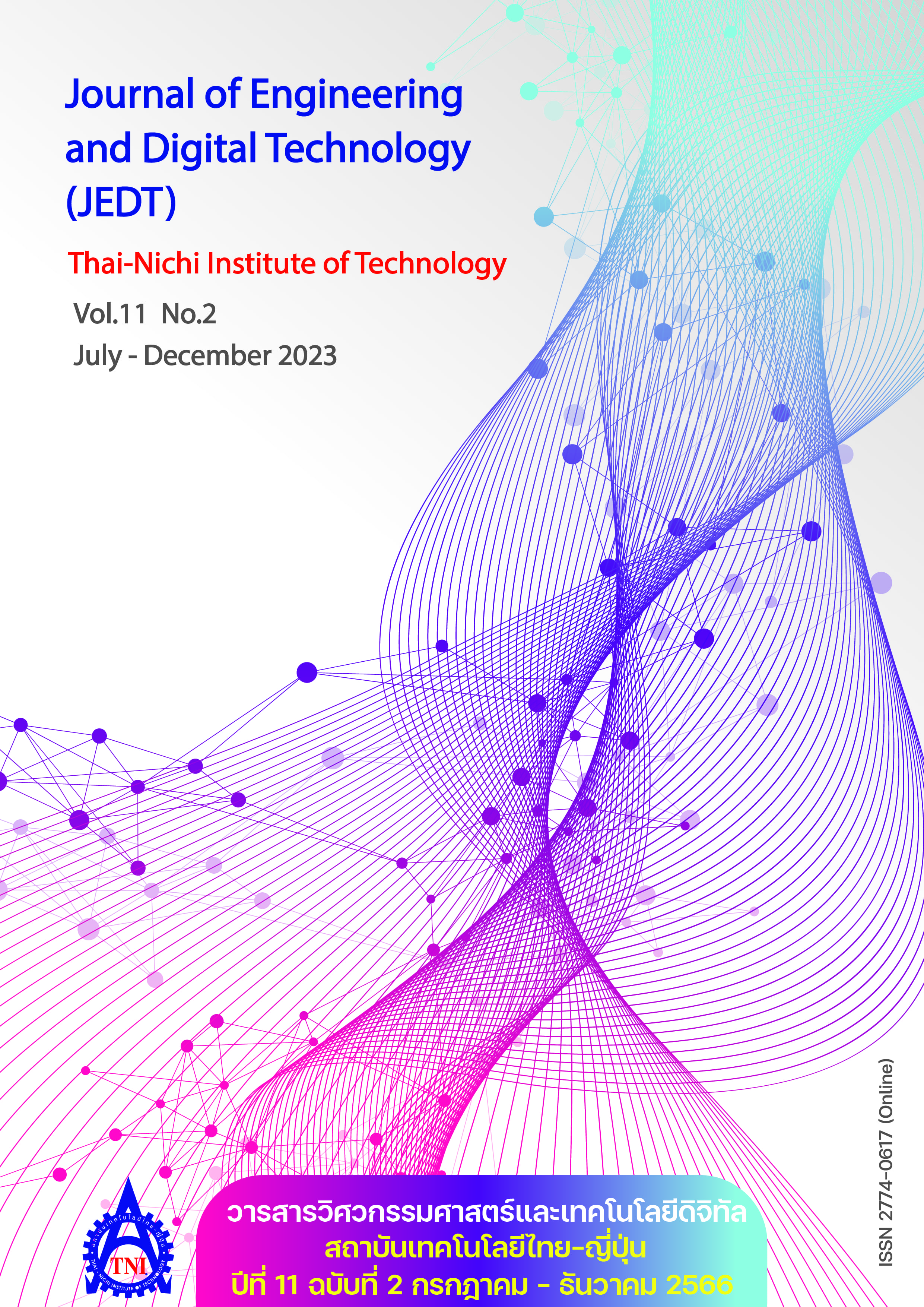Developing a Credit Approval Determination Model Using Principal Component Analysis with Machine Learning Techniques
Main Article Content
Abstract
This research presents a model and tests the performance of a credit approval determination model by using principal component analysis with machine learning techniques. Four algorithms: Naïve Bayes, Decision Tree, Random Forest, and Support Vector Machine were tested with 441,335 examples of lending data. There are four model performance test results: Accuracy, Precision, Recall, and F-Measure.
From the experiment, it was found that the random forest model provides the best accuracy performance of 92.90 percent, followed by support vector machine and decision tree is 87.00 percent, and Naïve Bayes is 83.40 percent, respectively. It was found that reducing the data dimensions resulted in improved model performance by eliminating insignificant features and solve the problem of the traditional credit approval model that considers the old attribute variables. The model's performance has improved by considering new attribute variables. The results of the completeness value (Recall) and the overall performance measurement value (F-Measure) from the experiment found that Random forest model provides the best performance as well as accuracy values were 99.64 and 99.35 percent, respectively, and the highest precision value was 99.07 percent for the random forest model and decision trees.
Article Details

This work is licensed under a Creative Commons Attribution-NonCommercial-NoDerivatives 4.0 International License.
Article Accepting Policy
The editorial board of Thai-Nichi Institute of Technology is pleased to receive articles from lecturers and experts in the fields of engineering and technology written in Thai or English. The academic work submitted for publication must not be published in any other publication before and must not be under consideration of other journal submissions. Therefore, those interested in participating in the dissemination of work and knowledge can submit their article to the editorial board for further submission to the screening committee to consider publishing in the journal. The articles that can be published include solely research articles. Interested persons can prepare their articles by reviewing recommendations for article authors.
Copyright infringement is solely the responsibility of the author(s) of the article. Articles that have been published must be screened and reviewed for quality from qualified experts approved by the editorial board.
The text that appears within each article published in this research journal is a personal opinion of each author, nothing related to Thai-Nichi Institute of Technology, and other faculty members in the institution in any way. Responsibilities and accuracy for the content of each article are owned by each author. If there is any mistake, each author will be responsible for his/her own article(s).
The editorial board reserves the right not to bring any content, views or comments of articles in the Journal of Thai-Nichi Institute of Technology to publish before receiving permission from the authorized author(s) in writing. The published work is the copyright of the Journal of Thai-Nichi Institute of Technology.
References
Committee for the Protection of Credit Information. “Basic Information about Credit Scoring.” (in Thai), CREDITINFOCOMMITTEE.or.th. https://www.creditinfocommittee.or.th/Public/BasicIntormation (accessed Mar. 1, 2023).
Supervision Group, Bank of Thailand. “Credit scoring, things that need to be preserved.” (in Thai), BOT.or.th. https://www.bot.or.th/th/research-and-publications/articles-and-publications/articles/Article_22Jan201.html (accessed Mar. 1, 2023).
P. Moeynoi. “Dimensionality Reduction.” (in Thai), MEDIUM.com. https://medium.com/@doohpim/02-การลดมิติข้อมูล-dimensionality-reduction-a5df2adb4f92 (accessed Sep. 7, 2022).
S. Teerawittayakul, “Ransomware detection study using machine learning techniques from a sample attack dataset,” (in Thai), Dept. Data Commun. Netw., King Mongkut's Univ. Technol. North Bangkok, Bangkok, Thailand, 2019.
PradyaSin. “What is Random Forest.” (in Thai), MEDIUM.com. https://medium.com/@pradyasin/random-forest-คืออะไร-74d2a0af3d7 (accessed Sep. 7, 2022).
B. Pasilatesang, Build Learning for AI with Python Machine Learning. Bangkok, Thailand: SE-EDUCATION (in Thai), 2021.
C. Ambi. “Difference Between Normalization and Standar-dization.” TOWARDSAI.net. https://pub.towardsai.net/difference-between-normalization-and-standardization-745030eaf96f (accessed Sep. 7, 2022).
E. Pacharawongsakda, Practical Data Science with RapidMiner Studio 1. Nonthaburi, Thailand: IDC Premier (in Thai), 2022.
Lending Club Loan Data: Complete loan data for all loans issued through the 2007-2015, including status, LendingClub 2007-2015, 2021. [Online]. Available: https://www.kaggle.com/datasets/adarshsng/lending-club-loan-data-csv
N. Promrita and S. Waijanya, Fundamental of DEEP LEARNING in Practice. Nonthaburi, Thailand: IDC Premier (in Thai), 2021.
T. Kaewsri. “Feature Engineering.” (in Thai), MEDIUM.com. https://grimreaperjunior.medium.com/สกัดข้อมูลให้ตรงใจด้วยการทำ-feature-engineering-bcdba80124bc (accessed Sep. 7, 2022).
S. Tidta and T. Kangkachit, “Automated system for employee welfare loan approval through machine learning techniques,” (in Thai), DPU Graduate Studies J., vol. 10, no. 2, pp. 93–107, 2022. [Online]. Available: https://grad.dpu.ac.th/upload/content/files/year10-2/10-7.pdf
B. Chitambira, “Credit scoring using machine learning approaches,” M.S. thesis, Division Math. Phys., Malardalen Univ., Vasteras, Sweden, Jun. 2022. [Online]. Available: https://www.diva-portal.org/smash/get/diva2:1664698/FULLTEXT01.pdf
C. Muangthanang, S. Mungsing, and N. Chirawichitchai, “Development of a credit scoring model using data mining techniques,” (in Thai), Huachiew Chalermprakiet Sci, Technol. J., vol. 7, no. 1, pp. 82–93, 2021.
R. Bai, H. Mo, and H. Li, “A comparison of credit rating classification models based on spark-evidence from lending-club,” Procedia Comput. Sci., vol. 162, pp. 811–818, 2019.


